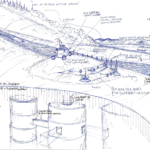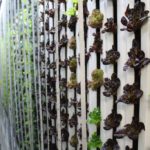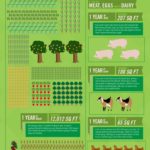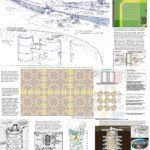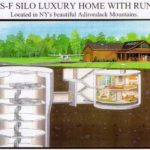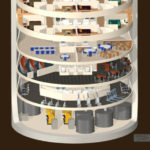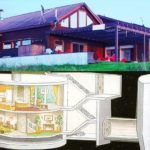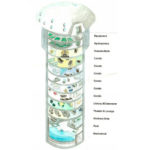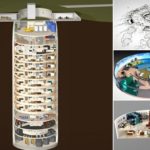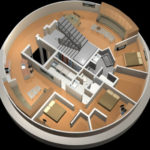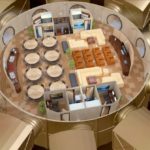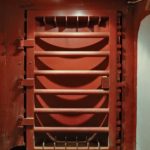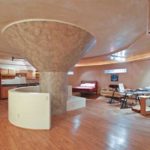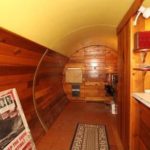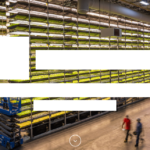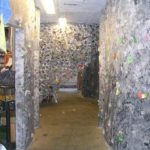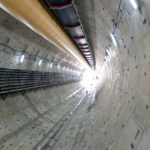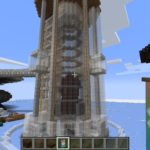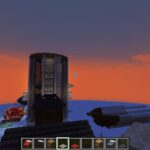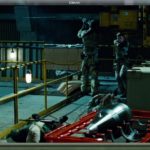Underneath your feet everywhere you may roam on Inisfree’s 100 square miles of surface… is an underground silo.
–
Table of Contents:
- Introduction
- The Grid
- Measurements
- Multiple Types
- Shipping-container Kitchen-units
- Underground Farming Specifics
- Weapons Forges
- History
- Novels Excerpt
- Overall (Images Begin)
- Designs
- Interiors
- Structural Skeletons
- Climbing Gyms
- Linking Tunnels
- Concepts/Memes
- 2023 Update: 2022 Full-size Model in Minecraft
- 2023 Update 2: Alison Showing How It’s Done
- 2023 November Update: Ballasts
–
Introduction:
Silos in Inisfree are not like the grain silos on the surface of many Outlander farms. They are more akin to the subterranean nuclear-missile launch-silos, except that none of them are designed solely for the purpose of housing nuclear missiles. * Their primary function is storage, with their secondary (emergency) function being to immediately drain any excessive rain or flood waters in such a way as to not sweep away, trap, or otherwise harm anyone (and their extensive interconnected network of sensors ensures this).
–
The Grid:
‘The Grid’, when spoken by Inisfreeans, refers to the grid-like layout of all of the silos relative to one another; every silo in Inisfree is underground, grouped in a cluster of nine silos total, connected amongst each other (the other silos in their cluster) by smooth tunnels, and connected to their adjacent silo clusters by additional, smooth tunnels.
Though not originally envisioned when the terraforming supercomputer called “The Grid Mind” was developed, it is very fitting, and certainly no coincidence, that it ended up being what formed/constructed and now manages this grid of silos.
–
Measurements
Cluster Dimensions:
- Each cluster: 3×3 silos (9 total in a square formation like a Tic-Tac-Toe board)
- Occupying space: c.210’^2 (~70′ span x 3 silos)
- Every silo in every cluster is on the same level/altitude/depth as its neighboring silos; all 9 silos in any cluster are all at the same height as one another.
- If you add 2 of the 4 sides of linking-tunnels, and keep each silo-cluster as aligned as possible to the city-map’s green-pixels surface-grid, each silo-cluster can be said (with half the distance of its surrounding linking-tunnels) to span ~264′; exactly 4 pixels on the city-map (or 2 of the green squares/’dots’, plus 2 of the empty spaces in between them).
- In Inisfree’s 10×10-mile habitation-area, you can have 200 of these silo-clusters from one side to the other; 200×200 = 40,000 silo-clusters.
- 40,000 silo-clusters x (~80 to ~1,000 people living in/on each cluster) = room beneath the surface of Inisfree for ~3,200,000 to ~40,000,000 human-sized people.
- Every time you construct another layer of this silos-network/grid, you create room for another ~3,200,000 to ~40,000,000 human-sized people.
- Thus a 2-layer silos-grid will provide all the housing/space/food we need, even “at capacity” (projected population/guests) millennia ahead; ~2,000,000,000 annual residents/guests, at roughly 154,000,000/month, when the neighborhoods provide housing for up to ~26,000,000, and the hotels and other lodging-capable buildings provide housing for another ~51,000,000, means that a remaining ~77,000,000 guests/residents at any given time will still need to live somewhere, and that ‘somewhere’ we already have available for them… is here (our habitation silos/clusters).
- Assuming most of those guests/residents don’t want to live as closely-packed as kajirae, but more like free-people (at ~2 to a silo-annex/container/studio), we’ll need to have (77,000,000 divided by 3,000,000) ~25 layers of this grid of linked silos/clusters. 25 layers of it (25 x 100′ + some solid-rock spacing in between) = ~3,000′ of depth. Due to some of our other underground structures/hollows, we won’t always be able to have that many stacked silo-cluster layers; we’ll add silo-cluster layers where we can.
Silo Dimensions:
- Space per silo: 71’^2 (including border/buffer around them, between them/it and the other/adjacent silos/green-belts/soil-belts)
- Silo diameter: c.30’ (and a c.10’ diameter central hole/shaft down through all/most levels)
- Silo height/depth: c.100’ (c.10 stories/floors/levels)
- Each 30′-diameter silo has ‘annexes’ extending off from each of its 10 floors, and each of those annexes is a shipping container that is ~20′ long (the standard minimum 20′ containers most human cargo-ships use, which we acquired/imported/ordered, then reinforced them to work in this underground role; so their sides wouldn’t collapse).
- Together with those annexes/containers, each silo is ~70′ in diameter; they are just slightly larger than our map pixels (a green square/’dot’ on our city-map representing a 66’x66′ area).
- Each silo has 4 or 8 annexes/containers per floor; each silo has 40 or 80 annexes/containers.
- These have been used like ‘tiny houses’ for troops on deployment, as well as by civilians in a more luxurious/creative way; they are proven perfectly suitable for habitation, and ~2 free-people or ~3 soldiers or ~12 kajirae can comfortably live in each 20′ shipping-container. (80-160 free-people can live in one of these 10-story silos, then, or 120-240 troops, or 480-960 kajirae. Since each silo-cluster only has 1 of its 9 silos designed/built for habitation, each silo-cluster is rated/recommended for the same occupation/population.)
Linking Tunnels:
- Connected via: 10’-diameter ‘horizontal-silo’ (cylindrical prism) tube-tunnels
- These tube-tunnels between clusters (connecting clusters; NOT the 10’-tunnels connecting silos in the SAME cluster, which are 5′-long) are: ~64’-long
- Each tube-tunnel: 10’-wide/diameter, and: white and gold, well-lit
- These tunnels may be horizontal most of the time, but anytime there is a surface-terrain/elevation change, such as in the case of a foothill with a dwelling on top of it, or in the case of the slope of the central mountain, these tunnels follow that surface-topography/slope; silo-clusters on the central mountain, for example, will have slanted/tilted connecting-tunnels, often requiring them to have no-slip walking-surfaces inside the tunnels, plus hand-railings, stairs, etc..
–
Multiple Types:
Silos are subdivided into the following types:
(updated/changed in 2022; see * below for the current types)
- KEEP: Personal Storage: used instead of the ugly, fenced or walled-off, U-Haul style, surface storage facilities of the Outlands.
- TRAIN: Climbing, Police, & Fire-rescue Training: these are also used for spelunking and military cave operations training.
- LIVE: Luxurious Basements: sometimes with condos and entertainment centers built in
- MAKE: Armories and Weapons-forges: these are also used for construction-materials storage, as well as vehicle and ammunition forges. *The weapons and ammo. they make, however, are of the Inisfreean kind/style now; they stop other weapons and incoming projectiles, and cause pleasure and persuasion, not primitive disfiguring damage.
- BALANCE: Environmental Regulatory: humidity, moisture, water table, surface temperature, topsoil temperature, Terra Preta checking & maintenance, fire control, controlled burns, flood flushing (storm-water drainage), static electricity consumption/dispersion/prevention, lightning strike dissipation, and soil enrichment.
- GROW: Back-up Green-houses: used for year-round growing, and for indefinite seed and crop storage (some with aeroponics, some with aquaponics, and others with hydroponics, each having the output of a 2-acre farm, but almost weekly instead of just annually or seasonally).
- MOVE: Dance Clubs: semi-industrial, bouncing platforms in the floor to reach basketball hoops and Lara-Croft-home-gym-style wall-poles for advanced break-dancing tournament moves.
- PROTECT: Metal Storms: high-volume, silenced, cavitating, smart-artillery (and ICBM-capable) launch platforms (though the projectiles in Inisfree are designed to heal, stop contamination, plant diverse forests, influence the weather, and so on). *These are also what launch our city’s fireworks during holidays. (We don’t sell/allow personal fireworks.) *For those Metal Storm silos which are beneath a residence or other surface structure, they can fire/launch their contents/projectiles via portals, or the Grid Mind can transfer their projectiles to vacant slots in nearby Metal Storm silos via portals it remotely makes.
- OVERCOME: Mandaloriday Stasis: indefinite ‘sleeping’ (hibernation) chambers for the smaller of Inisfree’s two types of biomechanical BattleMechs.
With 40,000 silo-clusters in Inisfree, that means there are
- 40,000 of each of those types of silos;
- we have 40,000 underground silos devoted to storage,
- another 40,000 devoted to climbing/spelunking training,
- another 40,000 devoted as luxurious bunker-like living-spaces,
- another 40,000 with 3D-printers in them capable of manufacturing custom defensive tools,
- another 40,000 which regulate various aspects of our surface terrain,
- another 40,000 which grow food no ‘bad weather’ or similar events can harm (and imagine how many people we can feed with 40,000 silos x 10 floors per silo x at least 4 shipping-container annexes per silo floor; 1,600,000 FreightFarm-like aeroponic/hydroponic crop-growing devices x ~7-20x the output of the same square-footage of normal farmland; producing what ~3,456,000,000 sq.ft. of farmland would (in /on 256,000,000 sq.ft.); ~79,338.8 acres worth of produce each harvest; the food you could grow on ~124 square miles of arable land; an ~11×11 mile farm; bigger than most major cities),
- another 40,000 where full-body healthy and fun movement can be practiced and enjoyed,
- another 40,000 which can launch barrages/swarms of reforesting missile-based seed-planters/pods (or other devices),
- and 40,000 which (other than for several occupied by one of our Mandaloridays) are still available for customization based on whatever changing needs we may have in the millennia ahead.
*2022 Update/Change:
Since most people don’t use the silos in the cluster under their home for
- dancing (since we have classes and 51 clubs for this),
- storage (no one has that many things to store, since no one brings anything to Inisfree except themselves),
- training (which is done almost entirely on the surface),
- or weapons forges (as we’re invincible after enough time in Inisfree, and already have our Perimeter Wall cannons and own Star Fleet),
and since the environments above them don’t need much regulating or re-seeding,
and since there are only a handful occupied by a Mandaloriday,
those (7) types of silos can all be used to grow food; we can multiply the calculated capacity of the silos clusters to produce food by 8.
No longer using up an entire silo in each cluster:
- dance
- environmental regulation
- Mandaloriday hangar/stasis
- metal storm
- storage
- training
- weapons forge
Still using an entire silo (worth of container-annexes) in each cluster:
- crops growing
- living
This dramatically increases Inisfree’s capacity to house people and grow food for them. It also dramatically increases those capacities for all of the 205,000 Inisfree-like cities in the SSA.
- 40,000 silos originally reserved for dance
- 40,000 silos originally reserved for environmental regulation devices
- 40,000 silos originally reserved for forges
- 40,000 silos originally reserved for the ICBM-scale equivalent of Metal Storms
- 40,000 silos originally reserved for supplemental storage units
- 40,000 silos originally reserved for training
- 39,990 silos originally reserved for Mandaloridays
- Total: 279,990 per city
- (x 205,001 cities in our empire = 57,398,229,990 silos)
- (x 40 shipping-container annexes per silo = 2,295,929,199,600 container-annexes)
- (x 40 shipping-container annexes per silo = 4,591,858,399,200 container-annexes)
Every silo (all 360,000 of them in/under the surface of Inisfree) will be stocked with “bug-out” bags; all the personal/emergency gear High King Auz takes with him on his expeditions, which includes many of the items his/our Gear Factory makes. There will be at least 1 of those bags/kits for every resident living in a home on the surface above. If, for example, a dozen people are living in the building above, the silo below it will have 1 dozen of these bags/kits, etc..
–
Shipping-container Kitchen-units:
Each of the silos in this network beneath the surface of our city includes at least one annex (shipping-container) built (3D-printed) from the start to be a highly-efficient kitchen. All the cooking appliances and utensils you’d expect/need in a quality kitchen are organized in these kitchen ‘box’ units. We based some of that on how the U.S. Army chose to design and field their own truck-transported version.
A video introducing the U.S. Army’s culinary-specialist loadout is here. (Pardon the occasional mask-‘tard in it.)
- 1 of these ‘boxes’ (shipping-container kitchen-units) = ability to feed 800 people 3x/day (d); 2,400 meals/d
- 40,000 silos x 10 floors x 4 of those ‘boxes’ per floor = 1,600,000 annexes; room for that many people to have their own annex, thus 3,200,000 to share an annex
- 3,200,000/800 = 4,000 of those Army mobile-kitchen ‘boxes’ needed (to provide 3 meals/day for the maximum number of people who are likely to ever live in this network beneath the surface of Inisfree)
- or 2B/800 = 2,500,000 of these ‘boxes’ (to provide 3 meals/day for the maximum foreseen number of residents and guests annually visiting Inisfree)
- 40,000/4,000 = 1 kitchen-‘box’ in every 10th silo, so ~1/cluster (which would be every 9th silo)
- vs. 2,500,000/40,000 = 62.5 in every cluster; at least 1 entire silo per cluster devoted to cooking (since each of our silos has 40-80 shipping-container annexes)
Thus the new silo-cluster silos assignments might be:
- Silo 1 of 9: Living Units (underground apartments), with ~1 container-annex per silo-floor just for growing crops, and ~1 container-annex per silo-floor just for cooking; a ‘box’ kitchen
- Silo 2 of 9: Living Units (underground apartments), with ~1 container-annex per silo-floor just for growing crops, and ~1 container-annex per silo-floor just for cooking; a ‘box’ kitchen
- Silo 3 of 9: Living Units (underground apartments), with ~1 container-annex per silo-floor just for growing crops, and ~1 container-annex per silo-floor just for cooking; a ‘box’ kitchen
- Silo 4 of 9: Living Units (underground apartments), with ~1 container-annex per silo-floor just for growing crops, and ~1 container-annex per silo-floor just for cooking; a ‘box’ kitchen
- Silo 5 of 9: Living Units (underground apartments), with ~1 container-annex per silo-floor just for growing crops, and ~1 container-annex per silo-floor just for cooking; a ‘box’ kitchen
- Silo 5 of 9: Living Units (underground apartments), with ~1 container-annex per silo-floor just for growing crops, and ~1 container-annex per silo-floor just for cooking; a ‘box’ kitchen
- Silo 7 of 9: Living Units (underground apartments), with ~1 container-annex per silo-floor just for growing crops, and ~1 container-annex per silo-floor just for cooking; a ‘box’ kitchen
- Silo 8 of 9: Living Units (underground apartments), with ~1 container-annex per silo-floor just for growing crops, and ~1 container-annex per silo-floor just for cooking; a ‘box’ kitchen
- Silo 9 of 9: Living Units (underground apartments), with ~1 container-annex per silo-floor just for growing crops, and ~1 container-annex per silo-floor just for cooking; a ‘box’ kitchen
Included in each silo-floor’s annex-kitchen:
- beverage dispensers, insulated the Yeti-cooler/thermos way
- cabinets (designed to never open accidentally open during flight) for baking trays, blenders, dishes, food processors, measuring cups, measuring pitchers, pans, pots, serving trays, 6″-deep half-pans and line-pans, etc.
- countertop for serving
- drawers (designed to never open accidentally during flight) for silverware, prep’ knives, bottle openers, ladles/dippers, regular serving spoons, slotted serving spoons, skimmers, food turners, scrapers, food scoops (for mashed potatoes, refried beans, ice cream, etc.), tongs, long-handle serving-forks, whisks, rolling pins, measuring spoons, recipe cards, hot pads, oven gloves, dishwashing gloves, etc.
- freezer
- heating cabinet; like a fridge, but to keep food at safely-hot serving-temperatures
- oven
- island for prep’
- refrigerator
- stove (with heat control cones around pots)
- utensils/cutlery and cooking tools; 1 of everything our Dishes & Utensils Factory makes
- vent-fans
–
Underground Farming Specifics:
We already explained how we have a total of 256 million sq.ft. of room devoted to growing food crops in this silos network of ours, and that its output is equivalent to 3,456,000,000 sq.ft. of farmland (almost 79,340 acres). With each of our FreightFarm-like shipping-container annexes able to grow up to 13,000 individual crops/plants at a time, we can be growing 20,800,000,000 individual plants with/in all of them. We will only have 2,000,000,000 residents and guests at our capacity a couple-dozen millennia ahead; we have the capacity to produce ~10.4 edible plants for each of those people… every ~month/harvest down here.
(On a surface farm with a normal day-night cycle, most crops take 70-120 days before their produce can be harvested, whereas down here in perfectly-controlled conditions with constant comfortable sunlight-like lighting and warmth… we get the same amount of growth ~3x faster, all from just increasing the amount of light per 24-hours each plant receives, and our controlled environments guarantee a near-100% harvest, no losses from weather, pests, or other common surface issues. We can also overlap the start of each group of plants in each of these container-farms of ours such that portions of each container’s crops become harvestable each week, making for a steadier supply of food, and more manageable harvesting days with less to carry up to the surface each time/week.)
Since 1 FreightFarm (a 40′ x 8′ shipping container’s floorspace; 320 sq.ft.) has an output of ~2 acres of normal outdoor farmland (87,120 sq.ft., because a FreightFarm grows simultaneous layers of crops, not just one on the ground, and because it produces more harvests each year than outdoor farmland can), it can be said to provide lots/plenty of food for the average family (~4 people); most people throughout history have been able to grow all they need on 2 acres. (87,120 sq.ft. / 320 sq.ft. = 272.25, and 272.25 / ~7/+ vertical levels of crops in a container-farm = ~39 cycles/harvests from 1 of those 40′ container-farms to match that produced on a 2-acre outdoor farm in 1 year’s growing season. *However, crops produced in container-farms are more reliable, and take only ~2% of the water outdoor crops usually require, due to preventing runoff and evaporation, etc., thus the high output per container-farm.) Inisfree’s equivalent of a FreightFarm is a half-sized container unit; ours, as noted above, are 20′ deep (“long”), so each of our container-farms can be expected to annually provide closer to 1 acre of normal farmland’s produce, feeding ~2 people per year.
It all started with testing the first container-farm, 3D-printing clone-like copies of all the different seeds we knew we should be growing, and having ICVs handling the ~weekly monitoring and harvests down here. We only activated more of these farming annexes in our silos network based on confirmed upcoming needs; we made sure all of our incoming guests and returning residents would always have at least one of these container-farms in this sub-basement of theirs, every occupied/used residence and other (occupied or used) structure in Inisfree having one on and producing at all times. This meant, for example, that in 2021 (when we had ~1,100,000 people visiting Inisfree per year; ~84,615 per month, on our 13-month calendar) we had ~42,308 of our underground container-farms on and producing, ensuring we could always cover their sustenance needs –even if all our surface crops somehow couldn’t/failed.
The amount of water required to cover one acre to a depth of one foot is equivalent to 43,560 cubic feet or 325,851 gallons. One acre = 43,560 square feet, so that comes out to ~7.5 gallons per square foot of surface/outdoor farmland. FreightFarms use/need only 2% of the water the same square footage of surface/outdoor farmland would/does, as they precisely control and reuse all the water in their system; ~.15 of a gallon per square foot. Each of our 20′ container-farms (20′ x 8′; 160 sq.ft.), then, needs/has only 24 gallons (<5 normal/common 5-gallon buckets) of water cycling/circulating through it to provide all the water (and transport all the nutrients) its crops need –so 42,308 of that size container-farm (the # we had on and producing in 2021) takes/needs ~1,015,392 gallons, total (~75 swimming pools’ worth of water).
Even if we had all 1,600,000 of our underground container-farms on, which would mean providing them with ~38,400,000 gallons of water ~per growth/harvest period (~2,844 swimming pools’ worth), that would still be well within our capabilities/resources. With more than 8 of the miles-long river-sized canals in our city (not counting our many and gigantic moats), thousands of waterfalls, and an entire mountain capped with snow and ice, plus lakes and ponds, the water vapor in our local air, ships which can transport (in a variety of ways; shipping or portal-ing) incredible amounts of water and any other resource in at a moment’s notice, and being located on the Earth‘s continent with by-far the most water-ice (~2 miles deep in many places), we will never lack that relatively incredibly small amount of water needed to operate every single one of our container-farms. Plus, that water doesn’t just get used up, disappearing each time we grow our crops; some of it stays in them until they are consumed, then makes its way back out into our water system. This means we never have to replace any of it.
Our surface-farm (called the Cropland) has ~2,000,000 girls working it at any given moment (~153,846 ICVs, each of whom has a team of ~12 kajirae following her directions). Being surface/traditional farmland, it doesn’t get harvested more than once or twice each year (even though we could coax three or four annual harvests out of it if we wanted to; we have the knowhow and means/technology); most of those millions of girls are not that busy there during most of our 13 months each year (i.e. only harvesting and carrying/driving crops/food around during some weeks of just one of those months). Only a few hundred of those girls are regularly/daily needed in our biodomes up there; we have ~1,999,700 of them usually available/free to come down into our silos network to check on, and harvest, its container-farms’ produce. (Again using the 2021 example: 1,999,700 girls servicing 42,308 of these container-farms = ~47 girls per container-farm. Even at capacity in the 23000s and beyond, 1,600,000 container-farms would still = ~1 girl per container-farm –at which point, obviously, we would have some more ICVs and kajirae join them, keeping it easy/normal to pick and carry up all that produce/food.)
Even though we grow food crops in almost every area and region of our city (excepting the deserts, including the snowy summit of our central mountain), giving everyone everywhere here access to local fresh organic food year-round, we always have this backup system just in case there is any issue at all with our surface atmosphere, soil, or whatever. What is grown on our surface provides all the food everyone here needs, namely because we have more than one thousand acres devoted to farming, plus an edible garden and a farm/crops-room in every home and other building. This means we always have a surplus of food, and we use that for compost / compost-tea and other sustainable/reusable things, never wasting any of it (and there are no landfills in Inisfree, by the way, as our recycling is 100% efficient).
–
Weapons Forges:
Inisfreeans make things that reunify and heal, not harm or kill; High King Auz included a weapons-silo in each silos-cluster in his city-design because he grew up in a time before the Inisfreeans, and that time was full of evil beings who could not be unified or healed, nor even reasoned with, thus weapons were something he was used to being forced to resort to. Each silo in their city designed to be a weapons forge is divided into sections based on the category/class of weapons it makes (10 floors per silo; 10 categories/classes), and then each annex/room of that floor (of which there are always 8) specializes in making and storing just one of the weapons in that category/class. Here are the details, floor by floor:
- Basement 1: This is the closest to ground-level, thus the easiest to access and get things from, so the most frequently/likely-used weapons are made here, and that is ‘small arms’; annex 1 (of 8) makes and stores pistols (and their ammo., as is the case with all of the following; where the weapon is made, so is its ammo.), annex 2 is for revolvers, annex 3 is submachineguns, annex 4 is shotguns, annex 5 is rifles (including carbines, all/both: laser-based), annex 6 is sniper rifles (laser-based), annex 7 is grenade launchers, and annex 8 is arbalest/crossbows.
- Basement 2: ‘medium arms’; annex 1 (A1) is M249 (light machineguns we modified to no longer be jams-prone), A2 is M240N (medium machinegun variant classified as semi-light), A3 is RPK (Russian medium machinegun printed with materials to make it semi-light), A4 is AEK-999, A5 is H&K MG5, A6 is Kbkm wz. 2003, A7 is Mk 48 Maximi, and A8 is laser machineguns (rapid-fire lasers). See this list for other/all light machineguns.
- Basement 3: ‘melee weapons’; A1 is bats/maces, A2 is hunting knives, A3 is axes, A4 is swords, A5 is spears, A6 is throwing knives (balanced daggers), A7 is throwing stars, and A8 is shurikens.
- Basement 4: ‘archery weapons’; A1 is bows (self/simple-bows), A2 is (English) longbows, A3 is compound bows (string with pulleys), A4 is composite bow (cables and pulleys), A5 is recursive bows, A6 is takedown bows, A7 is gakgungs (Korean bows), and A8 is Mongol (recurved composite) bows.
- Basement 5: ‘personal explosives’; A1 is flashbangs, A2 is grenades, A3 is sonic grenades, A4 is electromagnetic-pulse grenades, A5 is nail grenades, A6 is claymores (anti-personnel mines), A7 is psychic grenades (that temporarily stop/disable telepathic/psychic powers), and A8 is temporal grenades (that temporarily cause nearby time to stop, or stop/disable time-based superpowers from working there).
- Basement 6: ‘swinging weapons’; A1 is chains (relatively short; meant for whipping/strangling –or just securing doors/vehicles), A2 is , A3 is flails (mace with the spiked ball on a chain), A4 is nunchaku (nunchucks), A5 is chain-darts (chain-whips), A6 is chain-daggers/knives, A7 is kusarigama (bladed bars on chains), and A8 is meteor-hammers (mace on a rope/chain-link).
- Basement 7: ‘medium-ranged weapons’; A1 is M72 LAWs (200m), A2 is Mk153 SMAW (250m), A3 is AT4 (300m), A4 is RPG-7 (330m), A5 is M47 Dragon (1,000m), A6 is BGM-71 TOW (3,750m), A7 is FIM-92 Stinger (3,800m), and A8 is FGM-148 Javelin (4,750m).
- Basement 8: ‘high-volume weapons’ (medium- and heavy machineguns); A1 is _, A2 is _, A3 is _, A4 is _, A5 is M2 Browning (50 cal.), A6 is M3M (an M2 Browning variant for helicopter mounts + higher rate of fire), A7 is M134 miniguns (electric Gatling guns –with “Infinity Packs”), and A8 is Metal Storms (box-sized pods/units).
- Basement 9: ‘flame-based weapons’; A1 is torches, A2 is click-lighters, A3 is blowtorches (meant for starting campfires), A4 is welding torches, A5 is cutting torches (nearly a lightsaber), A6 is lightsabers, A7 is flamethrowers, and A8 is fireball launchers.
- Basement 10: ‘shock-and-awe weapons’; A1 is landmines, A2 is roll-up mines (two metal bars that orbit each other), A3 is snare-catapult mines (hold one limb while launching the rest), A4 is , A5 is , A6 is , A7 is , and A8 is heuristic mines (which use sensors to learn about the people/creatures above/nearby, at which point they change their position or how they will explode).
*As always, the 3D-printers in these forge-silos can be commanded/programmed to 3D-print just about anything; they can always be switched to producing not weapons, but now the kind of clever devices Inisfreeans use so that they don’t need to resort to weapons.
Sequence: The thinking is that if we ever have to use any of our weapons to defend ourselves, we’ll likely need ‘normal’ (small/personal/portable) firearms before anything else (such as a basic pistol), and everyone will want (or, at least, need if not want) to have one, so that is why we place/make them closest to people’s living-altitude/s. Then, we suspect the next most-needed type of weapon will be machineguns, followed by bladed weapons, then grenades and related explosives, and then (if at all) ones such as the mace and meteor hammer, and then rocket launchers, then miniguns (electric Gatling guns), then flamethrowers, and (least of all) some of the custom (and especially gruesome/shocking/demoralizing) devices High King Auz designed while he was still in high school.
Together: On all of those floors, and in all of those annexes, where the weapon is made… so is its ammunition. Both are printed near each other, then stored together. None of the ammo can prematurely detonate, either, which might damage the nearby weapons or the facility’s structure itself; we designed them to not be capable of such things.
Versatile Ammunition: All the ammo. we 3D-print (and can refill) here is designed not just match the caliber of its respective firearm/weapon, but also to still function/fire in vacuum (i.e. Outer Space).
Anti-weapons: Perhaps it is more accurate to say that these are still weapons, but are based on the principle of doing no harm, or doing as little harm as possible. In other words, the bullets home in on other bullets, knocking them out of the sky, or freezing them in place (i.e. putting a stasis field around them just long enough to remove all of their velocity/momentum), and grenades and mines detonate in ways that spread pleasure overloads, not shrapnel, etc.. How is all this possible? It isn’t challenging for trillions upon trillions of supercomputers (i.e. the ICVs) figuring it out together, which they have been… for more than a decade now (as of 2021).
Perception Weapons: We also have hallucination grenades and hallucination gas, not explosive grenades or tear gas, meaning that anyone not immortalized by Inisfree/Auz… will start to see the Inisfreean teammates as their allies/angels/besties, and their fellow human bad-guys/hostiles/fools as their worst fears, such as horned demons with glowing eyes, etc., causing them to turn on each other, thus freeing up the Inisfreeans to continue with their mission, no longer harassed/distracted/hounded.
Discerning: All the weapons these forges 3D-print and keep stored down here are designed from the start to only function in the hands of someone approved to be in/allied with Inisfree. That means that even if all of Inisfree was overrun or wiped out, and all of these weapons were taken out of their storage silos (armories), they wouldn’t fire –or even turn on. As Inisfreean creations, they can also be tracked and remote-disintegrated (if not just portal-based recalled back to their assigned shelves/spots here in Inisfree).
Authorization: Unless there is an unbelievable situation, like the actual penetration/infiltration of this hidden city of ours, these weapons and their ammo. shall forever remain locked down here in the silos that make and store them. No one is allowed to come down to any of these forges/silos to just “check them out” or take them to a range. Inisfree is a place of peace and compatible polyamorous people, not combat and warriors.
–
History:
Based on each cluster having 1 food silo, and each silo having 10 floors x 4 to 8 annexes, and Inisfree’s population being only ~10k human workers/volunteers during that/its 1st yr, and 12 guests the 2nd yr, …40 to 80 container-farms per food silo, and each container-farm being capable of feeding dozens to hundreds of people at least a salad portion of their diet, … that means only 3 to 5 food-silos were needed and active during the first few years of Inisfree.
The 40k silo-clusters were mostly just hollow/empty/frames until our population increased. We got them growing/providing as needed, always in anticipation of increases in guests and residents who needed the type of food we grow in them. Since more than 1,000,000 human-sized people visited Inisfree in and shortly after 2015, ~250 to 400 food-silos were activated for that time / those guests.
All 40,000 clusters (considering the average/projected output of the 40,000 food-silos that are part of those clusters) could theoretically provide enough plant-based food for 80,000,000 to 160,000,000 human-sized people, possibly more. That means that it won’t be until 3000 or even 5500 A.D. that Inisfree needs to have all of its food-silos activated/producing (and this doesn’t factor in all the food produced by its main farm, the Cropland).
–
Novels Excerpt:
Opening up a grass-covered square ‘door’ in the ground nearby, he showed her how to find and access one of the many entrances to Inisfree’s underground. All over their city, just a few stories down below the surface, was a network of tall, multi-floored rooms like grain silos, all arranged evenly in a perfect grid. They called it their Silos Network, and the silos were grouped in 3×3 clusters of 9, each silo in each cluster serving a distinct function.
The purpose was to provide additional storage, backup materials, food-growing capabilities, and shelter for Inisfree’s population of residents and guests. Should the sky-dome ever be off during inclement weather outside, people could use these tunnels and silos to traverse the entire expanse of the city without ever having to be exposed to the elements above. Even a meteor shower would be of little concern to those walking and working around down in here.
Unlike the underground levels and passageways of human cities, Inisfree’s Silos Network was spotless, well-lit, and intelligent; it only kept the lights on in the tunnels and silos in current use. It also made sure the air was fresh and breathable, and that the crops growing in some of its silos stayed alive. In a way, it looked like the Glowing Art Highway up above; a smooth white base, with areas of inlaid gold, indirect lighting, and no congestion of foot- or vehicle-traffic at all.
–
Overall:
–
Designs:
–
Interiors:
–
Structural Skeletons:
–
Climbing Gyms:
–
Linking Tunnels:
–
Concepts/Memes:
–
2023 Update: 2022 Full-size Model in Minecraft
–
2023 Update 2: Alison Showing How It’s Done
dynamic-entry and shooting drills
flooding/spelunking drills
–
2023 November Update: Ballasts
All 360,000 of these silos in our city can be used as ballasts. More accurately, since all their rooms/sections are waterproof/sealable, and because of their size, they can be called highrise-sized mega-ballasts. Even though this is probably never going to be necessary, thanks to the Uber Repulsines and other devices keeping our city upright/balanced, it is an option/backup/redundancy.
–

